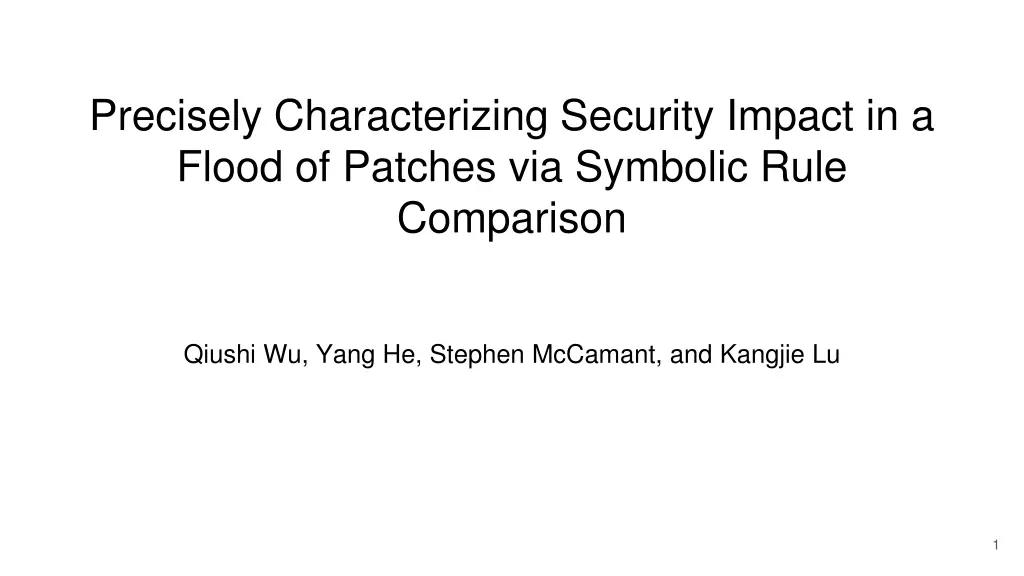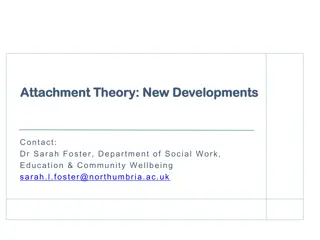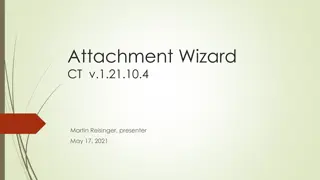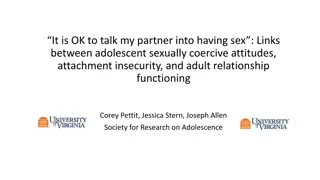
Identifying Security Bugs in Software Patches
Explore the necessity of identifying security bugs in software patches to address the increasing number of bug reports and potential vulnerabilities exploited by attackers. Learn about the limitations of traditional approaches and the goal of identifying patches for security bugs.
Download Presentation

Please find below an Image/Link to download the presentation.
The content on the website is provided AS IS for your information and personal use only. It may not be sold, licensed, or shared on other websites without obtaining consent from the author. If you encounter any issues during the download, it is possible that the publisher has removed the file from their server.
You are allowed to download the files provided on this website for personal or commercial use, subject to the condition that they are used lawfully. All files are the property of their respective owners.
The content on the website is provided AS IS for your information and personal use only. It may not be sold, licensed, or shared on other websites without obtaining consent from the author.
E N D
Presentation Transcript
Precisely Characterizing Security Impact in a Flood of Patches via Symbolic Rule Comparison Qiushi Wu, Yang He, Stephen McCamant, and Kangjie Lu 1
Motivation The overwhelming number of bugs reports Mozilla: ~ 300 bugs reports per day Linux kernel: More than 900K commits have been made ~165 git commits per day ... 3
Motivation The overwhelming number of bugs reports Patch propagation in derivative programs is hard and expensive Example: Many projects are derived from the Linux kernel 4 https://developer.solid- run.com/knowledge-base/linux- based-os-for-ib8000/
Motivation The overwhelming number of bugs reports Security bugs may not be fixed timely, and attackers have opportunities to exploit these security bugs Patch propagation in derivative programs is hard and expensive Maintainers are prioritizing to fix security bugs. Unrecognized security bugs may be left unpatched! 5
Our goal: Identify patches that are for security bugs
Traditional approaches: Text-mining Analyze textual information of patches to find security-related keywords. Statistical analysis Differentiate patches of security bugs from general bugs by using statistical information. Limitations: 1. Bad precision. 2. Cannot know the security impacts of bugs. 8
Limitations of traditional approaches: CVE-2014-8133 Permission bypass commit 41bdc78544b8a93a9c6814b8bbbfef966272abbe Author: Andy Lutomirski <luto@amacapital.net> Date: Thu Dec 4 16:48:16 2014 -0800 x86/tls: Validate TLS entries to protect espfix Installing a 16-bit RW data segment into the GDT defeats espfix. AFAICT this will not affect glibc, Wine, or dosemu at all. Signed-off-by: Andy Lutomirski <luto@amacapital.net> Acked-by: H. Peter Anvin <hpa@zytor.com> Cc: stable@vger.kernel.org Cc: Konrad Rzeszutek Wilk <konrad.wilk@oracle.com> Cc: Linus Torvalds <torvalds@linux-foundation.org> Cc: security@kernel.org <security@kernel.org> Cc: Willy Tarreau <w@1wt.eu> Signed-off-by: Ingo Molnar <mingo@kernel.org> 9
We prefer a program analysis--based method Understand the semantics of patches and bugs precisely A bug is a security bug if it causes security impacts when triggered. A patch is for a security bug when it blocks the security impacts 10
How to know if a patch blocks security impacts? 11
A security impact = A security-rule violation Security rules are coding guidelines used to prevent security bugs. Security-rule violations cause security impacts. We thus check if a patch blocks security-rule violations 12
Common security rules Rule 1: In-bound access Read & write operations should be within the boundary of the current object. Rule 3: Use after initialization A variable should not be used until it has been initialized. Rule 4: Permission check before sensitive operations Permissions should be checked before performing sensitive operations, such as I/O operations. Rule 2: No use after free An object pointer should not be used after the object has been freed. 13
Violations for common security rules Rule 1: In-bound access Rule 3: Use after initialization violation violation Uninitialized use Out-of-bound access Rule 4: Permission check before sensitive operations Rule 2: No use after free violation violation Use-after-free Permission bypass 14
A patch blocks security impacts if: If we can prove the following conditions: Condition 1: The unpatched version of code violates a security rule. Condition 2: The patched version of code does not violate the security rule. 15
Challenge: How to precisely determine the security-rule violations?
Intuition: We can leverage two unique properties of under- constrained symbolic execution.
Property 1: Constraints model violations Security-rule violations can be modeled as constraints Example: Buffer[Index]; Buffer access: Constraints for out-of-bound access: Index UpBound, and/or Index LowBound 18
Property 2: Conservativeness Under-constrained symbolic execution is conservative. False-positive solutions If the constraints are solvable, this can be a false positive. Proved unsolvability If it cannot find a solution against constraints, they are indeed unsolvable. 19
Leverage the properties for determining the security-rule violations Patch-related operations can be modeled as symbolic constraints To show the patched version won t violate a security rule To prove violating is unsolvable To show the unpatched version will violate the security rule To prove non-violating is unsolvable 20
approach: Symbolic rule comparison 1. Construct opposite constraint sets for the patched and unpatched version a. Patched version: Construct constraints for violating security rules b. Unpatched version: Construct constraints for not violating security rules 2. Check the unsolvability of these constraint sets 3. Confirm the patches for security bugs if both constraint sets are unsolvable 21
Rationale behind our approach For a security rule, the patched version NEVER violate it This means that the patched version is in a safe state 22
Rationale behind our approach For a security rule, the patched version NEVER violate it This means that the patched version is in a safe state In the situations that opposite to conditions of the patch, the unpatched version MUST violate this security rule This means that the unpatched version is in an unsafe state 23
Rationale behind our approach For a security rule, the patched version NEVER violate it This means that the patched version is in a safe state In the situations that opposite to conditions of the patch, the unpatched version MUST violate this security rule This means that the unpatched version is in an unsafe state The patch changes the code from an unsafe state to a safe state Precisely confirmed with property 2 24
Rationale behind our approach For a security rule, the patched version NEVER violate it This means that the patched version is in a safe state In the situations that opposite to conditions of the patch, the unpatched version MUST violate this security rule This means that the unpatched version is in an unsafe state The patch changes the code from an unsafe state to a safe state The patch fixed a security bug with the security impact that corresponding to the security rule violation. 25
STEP 1: Symbolically analyzing patched code // CVE-2012-6712 intiwl_sta_ucode_activate(... , u8 sta_id) { + if (sta_id >= IWLAGN_STATION_COUNT) { + IWL_ERR(priv, "invalid sta_id %u", sta_id); + return -EINVAL; + } 1 2 3 4 5 6 7 8 9 if (!(priv->stations[sta_id].used )) IWL_ERR(priv,"Error active station id %u " "addr %pM\n", sta_id, priv->stations[sta_id].sta.sta.addr); 10 11 12 13 14 15 ... return 0; } 27
STEP 1: Symbolically analyzing patched code Identify security operations. // CVE-2012-6712 intiwl_sta_ucode_activate(... , u8 sta_id) { + if (sta_id >= IWLAGN_STATION_COUNT) { + IWL_ERR(priv, "invalid sta_id %u", sta_id); + return -EINVAL; + } 1 2 3 4 5 6 7 8 9 if (!(priv->stations[sta_id].used )) IWL_ERR(priv,"Error active station id %u " "addr %pM\n", sta_id, priv->stations[sta_id].sta.sta.addr); 10 11 12 13 14 15 ... return 0; } 28
STEP 1: Symbolically analyzing patched code Identify security operations. // CVE-2012-6712 intiwl_sta_ucode_activate(... , u8 sta_id) { + if (sta_id>= IWLAGN_STATION_COUNT) { + IWL_ERR(priv, "invalid sta_id %u", sta_id); + return -EINVAL; + } 1 2 3 4 5 6 7 8 9 Extract critical variable. if (!(priv->stations[sta_id].used )) IWL_ERR(priv,"Error active station id %u " "addr %pM\n", sta_id, priv->stations[sta_id].sta.sta.addr); 10 11 12 13 14 15 ... return 0; } 29
STEP 1: Symbolically analyzing patched code Identify security operations. // CVE-2012-6712 intiwl_sta_ucode_activate(... , u8 sta_id) { + if (sta_id>= IWLAGN_STATION_COUNT) { + IWL_ERR(priv, "invalid sta_id %u", sta_id); + return -EINVAL; + } g 1 2 3 4 5 6 7 8 9 Extract critical variable. Slicin Identify vulnerable operations. if (!(priv->stations[sta_id].used )) IWL_ERR(priv,"Error active station id %u " "addr %pM\n", sta_id, priv->stations[sta_id].sta.sta.addr); 10 11 12 13 14 15 ... return 0; } 30
STEP 2: Collecting and construct constraints for patched code Collecting constraints // CVE-2012-6712 intiwl_sta_ucode_activate(... , u8 sta_id) { + if (sta_id>= IWLAGN_STATION_COUNT) { + IWL_ERR(priv, "invalid sta_id %u", sta_id); + return -EINVAL; + } 1 2 3 4 5 6 7 8 9 Constraints source Constraints sta_id < IWLAGN_STATION_CO UNT Security operations N/A Slice if (!(priv->stations[sta_id].used )) IWL_ERR(priv,"Error active station id %u " "addr %pM\n", sta_id, priv->stations[sta_id].sta.sta.addr); sta_id >= Bound of priv->stations 10 11 12 13 14 15 Artificial constraints (Security rules) Violating security rules ... return 0; } 31
STEP 3: Solving constraints for patched code Collecting constraints // CVE-2012-6712 intiwl_sta_ucode_activate(... , u8 sta_id) { + if (sta_id>= IWLAGN_STATION_COUNT) { + IWL_ERR(priv, "invalid sta_id %u", sta_id); + return -EINVAL; + } 1 2 3 4 5 6 7 8 9 Constraints source Constraints sta_id < IWLAGN_STATION_CO UNT Security operations N/A Slice if (!(priv->stations[sta_id].used )) IWL_ERR(priv,"Error active station id %u " "addr %pM\n", sta_id, priv->stations[sta_id].sta.sta.addr); sta_id >= Bound of priv->stations 10 11 12 13 14 15 Artificial constraints (Security rules) These constraints are unsolvable! ... return 0; } 32
STEP 3: Solving constraints for patched code // CVE-2012-6712 intiwl_sta_ucode_activate(... , u8 sta_id) { + if (sta_id>= IWLAGN_STATION_COUNT) { + IWL_ERR(priv, "invalid sta_id %u", sta_id); + return -EINVAL; + } 1 2 3 4 5 6 7 8 9 The patched version won t violate the security rule. if (!(priv->stations[sta_id].used )) IWL_ERR(priv,"Error active station id %u " "addr %pM\n", sta_id, priv->stations[sta_id].sta.sta.addr); 10 11 12 13 14 15 These constraints are unsolvable! ... return 0; } 33
STEP 1: Symbolically analyzing unpatched code // CVE-2012-6712 intiwl_sta_ucode_activate(... , u8 sta_id) { 1 2 3 4 5 6 7 8 9 Identify vulnerable operations. if (!(priv->stations[sta_id].used )) IWL_ERR(priv,"Error active station id %u " "addr %pM\n", sta_id, priv->stations[sta_id].sta.sta.addr); 10 11 12 13 14 15 ... return 0; } 34
STEP 1: Symbolically analyzing unpatched code // CVE-2012-6712 intiwl_sta_ucode_activate(... , u8 sta_id) { 1 2 3 4 5 6 7 8 9 Extract critical variable. Identify vulnerable operations. if (!(priv->stations[sta_id].used )) IWL_ERR(priv,"Error active station id %u " "addr %pM\n", sta_id, priv->stations[sta_id].sta.sta.addr); 10 11 12 13 14 15 ... return 0; } 35
STEP 1: Symbolically analyzing unpatched code // CVE-2012-6712 intiwl_sta_ucode_activate(... , u8 sta_id) { 1 2 3 4 5 6 7 8 9 Extract critical variable. Slicing Identify vulnerable operations. if (!(priv->stations[sta_id].used )) IWL_ERR(priv,"Error active station id %u " "addr %pM\n", sta_id, priv->stations[sta_id].sta.sta.addr); 10 11 12 13 14 15 ... return 0; } 36
STEP 2: Collecting and construct constraints for unpatched code Collecting constraints // CVE-2012-6712 intiwl_sta_ucode_activate(... , u8 sta_id) { 1 2 3 4 5 6 7 8 9 Constraints source Constraints - Security operations Slice - if (!(priv->stations[sta_id].used )) IWL_ERR(priv,"Error active station id %u " "addr %pM\n", sta_id, priv->stations[sta_id].sta.sta.addr); sta_id < Bound of priv- >stations Artificial constraints (Security rules) 10 11 12 13 14 15 ... return 0; } 37
STEP 2: Collecting and construct constraints for unpatched code Collecting constraints // CVE-2012-6712 intiwl_sta_ucode_activate(... , u8 sta_id) { 1 2 3 4 5 6 7 8 9 Constraints source Constraints sta_id >= IWLAGN_STATION_CO UNT Security operations if (!(priv->stations[sta_id].used )) IWL_ERR(priv,"Error active station id %u " "addr %pM\n", sta_id, priv->stations[sta_id].sta.sta.addr); Slice - sta_id < Bound of priv- >stations Artificial constraints (Security rules) 10 11 12 13 14 15 ... return 0; Non-violating security rules } 38
STEP 3: Solving constraints for unpatched code Slicing & Collecting constraints // CVE-2012-6712 intiwl_sta_ucode_activate(... , u8 sta_id) { 1 2 3 4 5 6 7 8 9 Constraints source Constraints sta_id >= IWLAGN_STATION_CO UNT Security operations if (!(priv->stations[sta_id].used )) IWL_ERR(priv,"Error active station id %u " "addr %pM\n", sta_id, priv->stations[sta_id].sta.sta.addr); Slice - sta_id < Bound of priv- >stations Artificial constraints (Security rules) 10 11 12 13 14 15 ... return 0; These constraints are also unsolvable! } 39
STEP 3: Solving constraints for unpatched code // CVE-2012-6712 intiwl_sta_ucode_activate(... , u8 sta_id) { 1 2 3 4 5 6 7 8 9 The unpatched version MUST violate the security rule. if (!(priv->stations[sta_id].used )) IWL_ERR(priv,"Error active station id %u " "addr %pM\n", sta_id, priv->stations[sta_id].sta.sta.addr); 10 11 12 13 14 15 ... return 0; These constraints are also unsolvable! } 40
STEP 4: Symbolic rules comparison The constraints for patched version are unsolvable! Violating security rules is unsolvable Patched version does not have an out-of-bound access The constraints for unpatched version are unsolvable! NOT violating security rules is unsolvable Unpatched version has out-of-bound accesses Conclusion: The patch blocks an out-of-bound access. 41
Advantages of our approach Very few false positives --- Special use of under-constrained symbolic execution 97% precision rate Determine security impacts of bugs By detecting security rules violations, it can identify security bugs and also their security impacts Easy to extend To cover more kinds of security impacts, users just need to model more types of security rules 42
Implementation Our prototype: SID Based on LLVM Currently support five types of common security impacts Out-of-bound access, permission bypass, uninitialized use, use- after-free, and double-free 43
Evaluation 44
Performance We analyzed 54K patches The experiments were performed on a desktop with 32GB RAM and 6 core Intel Xeon CPU The analysis takes an average of 0.83 seconds for each patch. 45
False-positive and false-negative analysis Few false positives We confirmed 227 security bugs with 8 false-positive cases. False negatives (can be reduced) 53% false negatives. Most of them are caused by incomplete coverage for security and vulnerable operations. 46
Security evaluation for identified security bugs Security impacts Already confirmed by SID Reachability Check the call chain from entry points to vulnerable functions 47
Security evaluation for identified security bugs Vulnerability confirmation for CVE 54 CVEs confirmed out of 227 identified bugs. 117 security bugs are still under review. Reachability analysis for security bugs 28 dynamically confirmed bugs (fuzzers). 154 are reachable from attacker controllable entry points, such as system calls. 21 security bugs still unpatched in the Android kernel. 48
Conclusions Timely patching of security bugs requires the determination of security impacts Patch propagation is hard and expensive So maintainers have to prioritize to fix the security bugs. We exploit the properties of under-constrained symbolic execution for the determination Our novel approach: Symbolic rule comparison Identified many overlooked security bugs in the kernel They may cause critical security consequences 49
Q&A 50





















